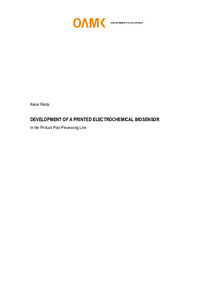Development of a Printed Electrochemical Biosensor in the PrinLab Post-processing Line
Ranta, Késia (2022)
Ranta, Késia
2022
Julkaisun pysyvä osoite on
https://urn.fi/URN:NBN:fi:amk-2022083119751
https://urn.fi/URN:NBN:fi:amk-2022083119751
Tiivistelmä
Printed electronics is a rapidly evolving industry. The components of printed electronics are used to supplement conventional electronics since the printed components are light weight, cost effective, and if necessary stretchable and flexible. PrinLab, a development laboratory of Printed Intelligence is located at Oulu University of Applied Sciences. PrinLab has a wide range of manufacturing and research equipment for printed electronics.
The purpose of the thesis is to verify manufacturability of printed electrochemical biosensor with updated post-processing line of PrinLab. The biosensor should be able to be manufactured reproducibly. The updated post-processing line can improve manufacturability. The post-processing line is a device originally made for PrinLab by Omron Electronics Oy and Oamk. Post-processing line is capable of dispensing very small amounts of solutions onto the unwound roll by means of a Cartesian robotic arm. The equipment was upgraded in April 2021, which also allowed solutions to be dispensed onto a stopped roll or sheet placed in the work area.
The theoretical framework provides the reader with a background on the printing and research methods used in the process, as well as the materials used and their properties. In this study, the author used previously at PrinLab manufactured screen printed sensor bases to which the selected biomaterial was dispensed in the post-processing line. Glucose oxidase was chosen as the biomaterial because of its availability and reliability. The purpose was therefore to verify the manufacturability of the sensor with upgraded equipment and to test the functionality of the sensor using electrochemical methods. Various alignment tests were performed on the equipment using candy dye. As the post-processing line is a device designed and assembled separately for PrinLab needs, it does not come with an instruction manual, which is why the device commissioning training was given orally by Tuomas Lipponen, an automation engineer at Algol Technics who updated the device.
After training, the electrochemical biosensor fabrication process was verified by dispensing glucose oxidase on four sheets, each containing 20 finished sensor bases. After visual inspection and electrochemical tests, it could be concluded that this method succeeded in producing a functioning electrochemical biosensor.
The purpose of the thesis is to verify manufacturability of printed electrochemical biosensor with updated post-processing line of PrinLab. The biosensor should be able to be manufactured reproducibly. The updated post-processing line can improve manufacturability. The post-processing line is a device originally made for PrinLab by Omron Electronics Oy and Oamk. Post-processing line is capable of dispensing very small amounts of solutions onto the unwound roll by means of a Cartesian robotic arm. The equipment was upgraded in April 2021, which also allowed solutions to be dispensed onto a stopped roll or sheet placed in the work area.
The theoretical framework provides the reader with a background on the printing and research methods used in the process, as well as the materials used and their properties. In this study, the author used previously at PrinLab manufactured screen printed sensor bases to which the selected biomaterial was dispensed in the post-processing line. Glucose oxidase was chosen as the biomaterial because of its availability and reliability. The purpose was therefore to verify the manufacturability of the sensor with upgraded equipment and to test the functionality of the sensor using electrochemical methods. Various alignment tests were performed on the equipment using candy dye. As the post-processing line is a device designed and assembled separately for PrinLab needs, it does not come with an instruction manual, which is why the device commissioning training was given orally by Tuomas Lipponen, an automation engineer at Algol Technics who updated the device.
After training, the electrochemical biosensor fabrication process was verified by dispensing glucose oxidase on four sheets, each containing 20 finished sensor bases. After visual inspection and electrochemical tests, it could be concluded that this method succeeded in producing a functioning electrochemical biosensor.
